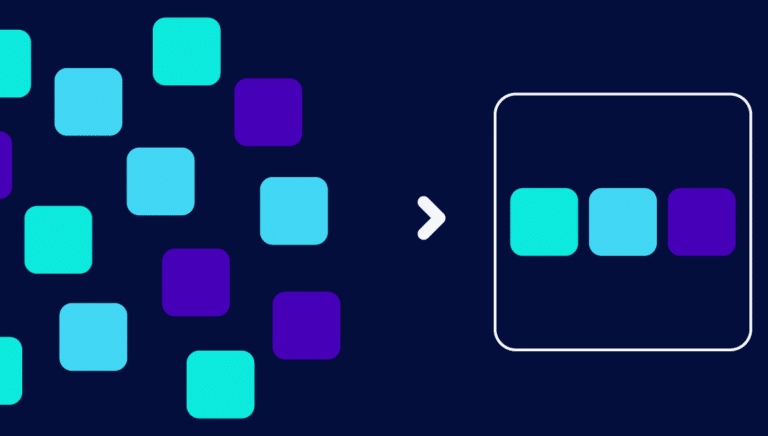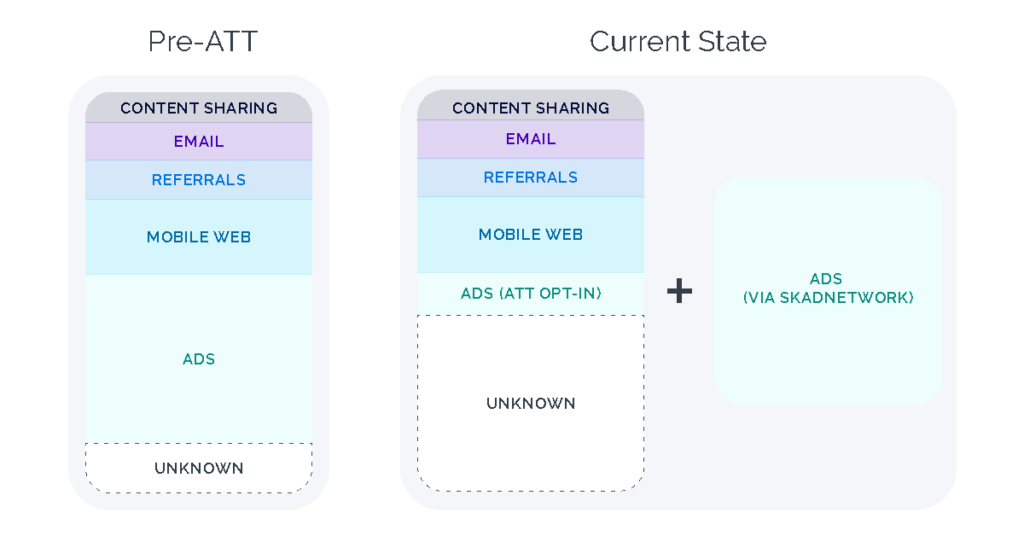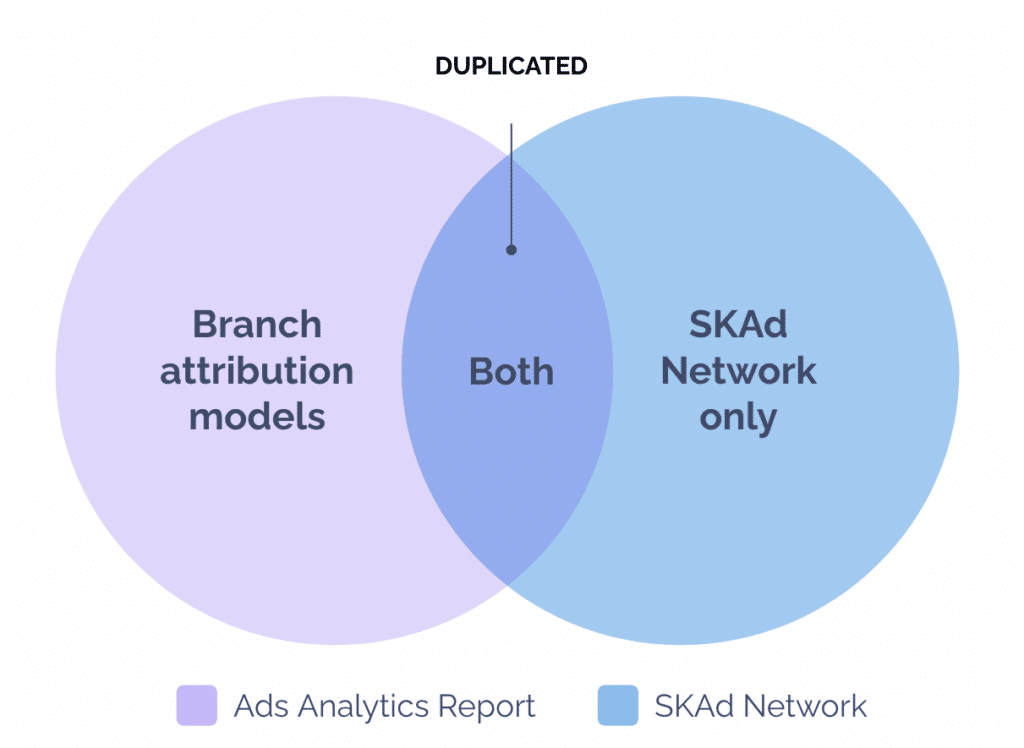Branch is thrilled to share our latest release: Unified Analytics!
With the existence of several versions of SKAN comes the challenge of understanding the attribution data it generates alongside every other attribution source. Enter Unified Analytics from Branch: now, it’s easier than ever before to see your data all in one place without having to cobble together information from multiple sources.
And you don’t have to worry about deduplicating your data, either — we’ll take care of that for you.
TL;DR:
With Unified Analytics, you can now:
- Analyze SKAN and non-SKAN cross-platform attribution data within a single unified analytics view.
- Accurately calculate metrics (such as eCPI, eCPA, ROI, ROAS, etc.) based on a corrected, deduplicated conversion count!
- Split your total deduplicated conversion counts into SKAN and non-SKAN via an easy-to-control toggle
- View the deduplicated data on installs and events in this report by default.
- Understand your true organic baseline.
In addition, the Branch platform has been updated to support your transition to SKAN 4.0.
This support includes updates to the Branch SDKs and SKAN Analytics view, alongside SKAN configuration tools. Check it out here!
Let’s discuss the specific problems marketing teams are struggling with today that SKAN Unified View uniquely solves for.
Why do you need Unified Analytics?
For a few reasons — but mainly because SKAN reporting changes the paradigm of how most marketers currently look at their data. This is what iOS attribution data looks like now:
Understanding iOS attribution data has become complex, and deduplicating this data manually is challenging.
To make informed decisions about how they allocate their spend, marketers that leverage this data require a single source of truth that accurately attributes events and revenue.
Attribution Pre-iOS 14:
MMPs attributed all iOS users back to paid campaigns using device-level attribution methodologies.
Of course, for users who opted in, deterministic attribution leveraging the IDFA was possible. But for users who opted out, MMPs could gracefully fall back to probabilistic attribution. Any complexity in attribution was handled behind the scenes, but for marketers, the performance data was seamlessly available in one single dashboard which included clear calculated metrics like eCPI, eCPA, ROAS etc.
Attribution iOS 14 onward:
With the introduction of ATT (App Tracking Transparency Framework) and SKAd Network (Apple’s aggregate level attribution methodology) in iOS 14, Branch and other MMPs started attributing iOS users back to paid campaigns using data from multiple data streams and disparate attribution methodologies.
Complexities (i.e. opted-in users vs opted-out users, device-level attribution vs. aggregate-level attribution via SKAd Network etc.) were introduced in the way marketers looked at the performance of paid ads.
For marketers, this meant that data for the same paid campaign was now available in two different reports/dashboards with different levels of granularity. Further, the absence of IDFA meant that it was difficult to tie the data together without including duplicate data.
So why can’t marketers simply add up numbers from the two reports?
These changes made it difficult for marketers to have a holistic view of campaign performance. Referring to multiple dashboards became a hassle, deduplication across attribution methodologies became harder, and misinterpretation of campaign results turned increasingly likely!
Getting accurate reporting on campaign metrics (like eCPI, eCPA, ROAS) and having a clear picture of the organic baseline — things that were taken for granted in a pre-ATT world — were now an uphill task for performance marketers.
As a result, the challenges marketers have had to face up until today were plentiful:
- Marketers needed to collate data from multiple dashboards. As a result, they either report erroneous performance numbers (by simply adding up conversion counts across reports) or struggle to apply custom deduplication logic on their end. Marketers also must manually correct when users are attributed as organic instead of non-organic media and that data more often than not lives on a separate dashboard.
- Parallel attribution through SKAN for opted-in users led to duplicate conversions. In other words, because of opt-in, there’s no reliable way to know if a user attributed in SKAN is showing up twice — a less-than-ideal scenario to be in.
- There was no easy way to view Android, iOS, and web data side-by-side, making it difficult to have a holistic view of campaign performance. There was also no accurate way to view key metrics (such as eCPI, eCPA, etc.) in a single place, making it extremely difficult to optimize based on partial or incomplete data.
Long story short: without a central, unified source of truth, marketers will struggle with the very high potential for manual errors and misrepresentation of campaign results.
What problems does Unified Analytics address — and how?
With this powerful tool, you can measure campaign data from all attribution methods (including SKAN) merged in a single view.
The Unified Analytics dashboard presents accurate performance data, as overlapping sets of users attributed via both SKAN and traditional MMP methodologies are deduplicated.
This means you can now accurately calculate metrics (such as eCPI, eCPA, ROI, ROAS, etc.) based on a corrected, deduplicated conversion count!
No longer do you need to collate data from multiple dashboards, nor struggle to apply custom deduplication logic on your end. You’ll also now be able to analyze SKAN and non-SKAN cross-platform attribution data within a single unified analytics view.
Additionally, you can now split your total deduplicated conversion counts into SKAN and non-SKAN via an easy-to-control toggle.
This ensures that organic counts within Unified Analytics are corrected/scaled down appropriately and helps you understand your true organic baseline.
As a result, you’ll be able to view the deduplicated data on installs and events in this report by default.
Branch has also built the necessary components to support transitioning to SKAN 4.0. These changes — including updates to our SDKs, our dashboard SKAN configuration tools, and an enhanced SKAN Analytics view within our dashboard — allow for a deeper understanding of signals from your iOS users.
When should I use Unified Analytics?
Branch’s Unified Analytics is now available within the Ads subsection of the Branch Dashboard to all Ads Attribution customers and supports a wide variety of use cases including (but not limited to):
- Marketing spend allocation: By having holistic and accurate performance reporting for iOS users, you can make quicker data-driven decisions on which channels to double down on, and better allocate budgets over time.
- Campaign reporting & optimization: You can now report on campaign performance and optimize campaigns on a day-to-day basis more effectively.
- Deduplication standardization: Makes it unnecessary for you to apply any custom deduplication logic on your end — and minimizes errors of double counting or over-reporting.
Internal alignment across stakeholders: Campaign performance numbers that your entire marketing organization can agree on.
What’s next?
Now it’s easier than ever before to see all of your attribution data in one place. That being said — while Unified Analytics supports all versions of SKAN, the mobile ecosystem still has some catching up to do to fully support SKAN 4.0.
In navigating the ambiguity, Branch can help you maintain business continuity. Meaning, you can continue running your SKAN campaigns and conversion reporting as you usually would.
While SKAN is continuing to change and develop as we speak, you can stay up-to-date on changes by checking out our latest blog posts:








